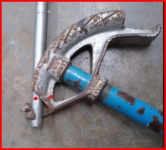This hand bender says 5’ take up for 90 degree bends as well as ugly book. However when you add 5 inches to any mark and bend at this point, the bend ends at 2 inches beyond desired distance before 5” mark
The bend is alway 3” take up and the stub arrow is used at marks. A level confirms 90 degree stub up so what could be the issue?
Do we use notch teardrop or star instead of arrow?
Try the
KISS method (Keep it simple stupid) forget what you thought you already read and understood.
Lay your conduit on the floor. Say you want a 16 3/8" stub up 90° on one end of the conduit. On the end of the conduit where you need the 16 3/8" stub up, take your tape and extend it out about 24" and lock it there. Place it on the floor next to the conduit (parallel). Overhang exactly 5" of the tape past the end of the conduit, (the 5" mark on your tape exactly equal with the end of the conduit end) where you need the stub measurement. Mark your conduit at the 16 3/8" spot on your tape, this will help you avoid math errors when dealing with fractions in your head, to begin with. When you make your mark, use a fine line marker or a pencil to maintain accuracy, and keep your mark at exactly 90° (perpendicular) to the center line of the conduit.
Now take your bender and place it on the conduit with
the hook end (arrow end) facing the end that you measured from. Line up your mark exactly with the center of the arrow head. Place the conduit and the bender on the floor for support. Use some foot pressure on the backside of the bender head, to force the pipe to the floor during bending pressure. Pull up on the handle, while holding the conduit to the floor with your foot pressure. Use a short length of channel strut against the backside of the conduit to measure the exact length of your stub up. It will also show you if the conduit is over or under bent, an adjustable head carpenter square can be used against the strut to check the accuracy of your bent angle for adjustment. If you carefully followed the measuring, layout, marking and bending instructions your stub up should be exactly 16 3/8". There should only be very minor variations from one batch of pipe to another, due to manufacturing tolerances, not because the take up on your bender is marked wrong. Try the KISS method and then report back if it worked for you or not.
In answer to your question, the problem is operator error in understanding the directions and terms. Practice makes perfect. Slow down and pay close attention to accuracy along the way and you will understand better and stop wasting conduit. but realize that it takes some mistakes to figure out the error of your ways
Once you get the arrow head layout figured out, then we can move on to explaining using the star mark for back to back bends. Save your practice sticks for the next lesson.




